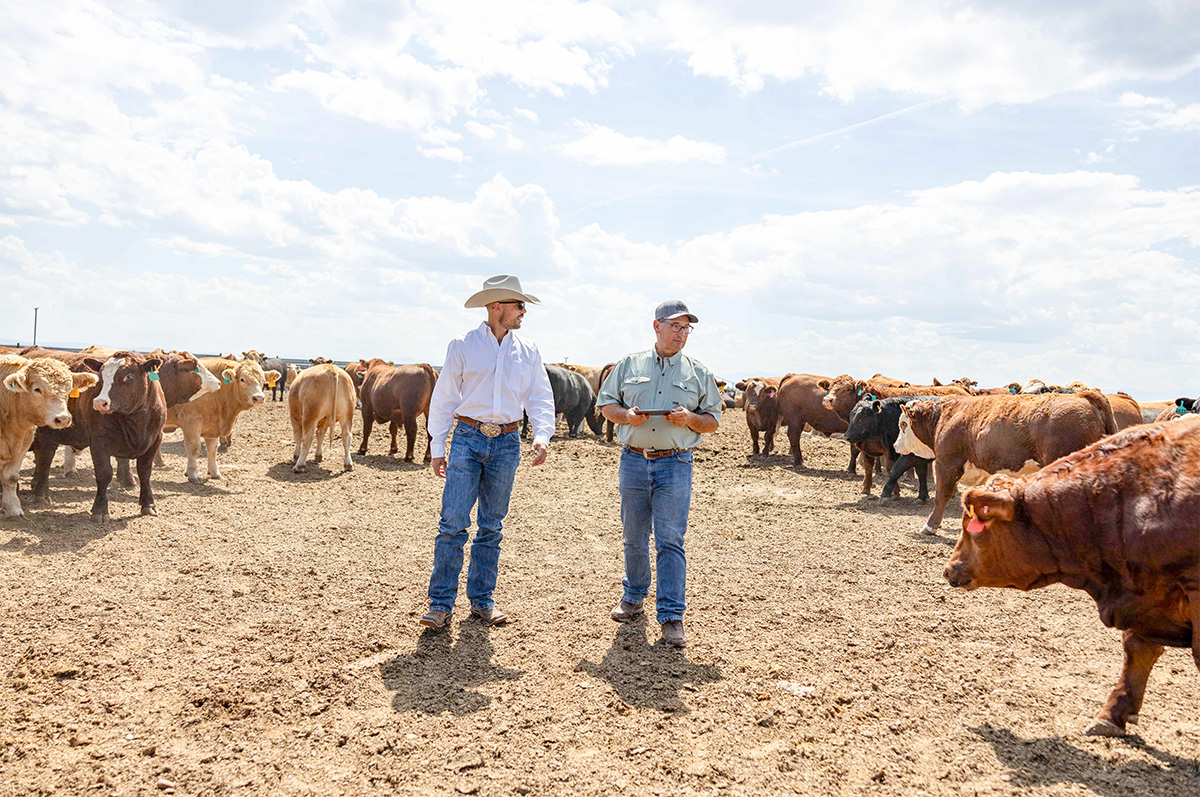Feedlot operators tap into their hard-earned instincts almost every minute of every day. Most also lean into data and information. When critical decisions need to be made, it can be difficult to choose the right lane. Should instinct or data guide the thinking, or is there an overlap? If they’re both valuable, how do producers find their appropriate balance?
When to rely on instincts
Breck Hunsaker, a veterinarian with Telus Agriculture, believes instincts are especially valuable during hypothesis generation and brainstorming.
“We can’t exhaustively test every single day of a feeding period, so we break it down into what makes sense,” he says. “For example, we use our senses to tell us if something should be done on arrival or at a scheduled rehandling event.”
Experience and instinct dominate cases of animal well-being. Putting out straw and bedding for calves during a snowstorm doesn’t need to be tested for economic viability. These types of management practices are done largely without background data.
Matt Quinn, a Telus production consultant, says many instances are initially founded in instinct but eventually lead to more of a reliance on information. Feedlot personnel may feel a condition is occurring, or based on their knowledge they recognize cattle are headed in a certain direction from a health perspective, but it’s a gut feeling without the tools to establish accuracy.
“We try to determine the X, Y and Z factors that we’re feeling are actually happening,” Quinn says. “Data is inexpensive for helping to measure these realities.”
Instinct might lead to a researchable hypothesis, the creation of a randomized evaluation or a formal commercial field trial to confirm or negate early views.
In other instances, producers successfully trust their instincts in the buying and selling markets. Their gut might tell them to ship animals or move up marketing days. These perceptions may be confirmed by implementing research-driven recommendations in their decision-making.
“It’s our job as consultants to formulate a plan to confirm instincts and transition them through a set of parameters supporting profitability and providing cost-effective solutions,” Quinn says. “It might be as simple as sorting, changing the market endpoint or the aggressiveness of growth technology. Information helps us capitalize on instincts.”
Leaning into data
Quinn says while risk management always plays a role, data helps confirm the feelings behind potential opportunities.
“Data collection tools help generate more informed decisions by guiding producers through the back end of their instincts,” Quinn says. “Projections from our animal health and production consultants show how well historically fed cattle and management practices match what they’re already thinking. It’s leveraging our information to bolster intuition and enhance profitability.”
On the animal health side of the equation, instincts often push hunches toward a decision, product or procedure.
Hunsaker points to new products and technologies as examples that may initially look like positives but carry significant profit-altering costs. Timing, frequency and dosage level questions become almost infinite. Instinct can narrow down when something makes sense or becomes feasible.
“If we can’t recover the cost plus some benefit, it’s simply an aerobic exercise,” Hunsaker says. “We could randomize cattle to determine which way the arrow is pointing – in other words, positive, neutral or negative – but most importantly, data shows us the economic impact of a decision.”
Cost vs. opportunity
During economic modeling, programs should offer sensitivity analyses to confirm accurate decision-making information.
“For example, during the last two years of drought with historically high feed prices, producers scrambled to squeeze every ounce of efficiency out of purchased commodities,” Quinn says. “This went hand in hand with capitalizing on growth technology to improve feed efficiency.”
However, these strategies must be balanced when input prices decrease. Thresholds will appear as additives used to maximize feed efficiency become more expensive than their potential response. Feed efficiency is worth less as input costs fall. A sensitivity analysis becomes a sliding scale to confirm where policies either do or don’t make sense.
“Lightbulb moments occur when our collection tools help customers manage populations differently, whether with feed and nutrition or by providing unique commodity opportunities,” Quinn says. “It could be better-aligned implant window protocols to fit marketing endpoints or using a tool like Telus’s Dynamic Sorting to proportionately group cattle for specific programs. It’s honing in on maximizing cost-effectiveness and enhancing profitability.”

Feedlot employees may sense a particular situation in their cattle before data can prove it. Experience in these situations will breed confidence in their decisions. Photo courtesy of Telus Agriculture.
An animal health sensitivity analysis is based on risk classes. Expensive products targeting bovine respiratory disease (BRD) metaphylaxis scenarios don’t make as much sense on heavier, low-BRD-risk animals versus BRD-susceptible lightweight calves.
“We plug individual values into the sensitivity analysis, helping to identify the point that strategies remain economically sound,” Hunsaker says. “It’s based on the response we’ve seen from a specific risk class. If we project 800-pound steers to have a mortality of 0.5 percent, costly BRD metaphylaxis or other costly interventions don’t have a prayer of being profitable because we’re never going to reduce mortality enough to pick up the cost.”
Alternatively, as BRD metaphylactic treatments become cheaper, their usefulness changes and broader applications across different classes become more viable.
Hunsaker explains enhanced efficiencies and convenience for vaccines, boosters or metaphylactic intervals tend to catch his clients’ attention.
“Clients’ eyes light up when they see opportunities from combining instinct, data and cost-benefit analysis,” Hunsaker says. “It improves profitability, plus reduces costs and labor. People get excited when we talk specifics; [for example], 15-dollar-per-head savings are confirmed by our randomized studies using the complexity of biological outcomes, such as morbidity or mortality and economic modeling.”
Key areas for decision-making affecting outcomes
Nutrition is a key area where perceived opportunities could arise. New or unknown commodities, diet formulation, feed additives or implant protocols might spark feelings of potential just begging for evaluation. But how does this play out?
“It’s probable that studies have already been done by us or others with these options and have confirmed relevant findings based on previous data,” Quinn says. “Our experts create outcome confidence since we’ve already worked on so many evaluations.”
If the information isn’t there, formal trials with randomized cattle are created to base findings and build confidence. Information databases are constantly growing with products, strategies and management practices.
Animal health is also key to decision-making demanding two separate areas of attention.
First, the mortality reduction of appropriately randomized cattle and field trial executions confirms precise ROI for both products and their timing.
Second, an assessment of the underlying risk of the population can affect animal health protocol recommendations that may lead to the use of products for prevention of diseases, even in the event of rarely occurring outbreaks.
“Prevention strategies for clostridial diseases such as tetanus or blackleg are often hard to confirm as cost-effective until we have a wreck,” Hunsaker says. “It becomes immediately obvious that for less than a dollar per head these situations could have been avoided. We make these decisions based on risk or associated liability.”
Producers might use physical or virtual sorting tools to refine weight variances helping to avoid light or heavyweight carcass discounts. This targeted time and endpoint marketing delivers more control by cost-effectively maximizing profitability.
Digital postmortems also add value and impact the outcomes of decision-making. Rather than veterinarians completing necropsies during monthly feedlot visits, digital technologies outline prescribed methods and procedures. Images are captured and uploaded for consulting veterinarians to make diagnoses on an ongoing basis instead of during occasional site visits.
“Verified accuracy drives profitability down the line,” Hunsaker says. “Our gut may point to respiratory mortalities, but postmortem evidence might confirm something adjacent. We avoid chasing the wrong rabbits. Instead, we’re tailoring solutions for treating and controlling these occurrences.”
Hunsaker believes the consultant’s role is to interpret and guide decisions based on instinct and data. “We don’t spit out random ideas or concepts; we say in this instance we could use this approach, technology, strategy or procedure, but not in another situation.”
Quinn adds that sticking with a formerly randomized and evaluated discipline where data guides and drives the decision-making process is key to all factors of production.
“We can fine-tune an operation’s efficiency, knowing when to use appropriate products,” Quinn says. “More accurate decisions relative to commodities or animal health will ultimately lead to improved efficiency, added labor savings and more profit. In these cases, we’re making decisions balancing instinct, experience, and accurate and confirmed data derived from research-driven recommendations.”
Bruce Derksen is a freelance writer based in Lacombe, Alberta, and was paid by Telus Ag to write this article.










